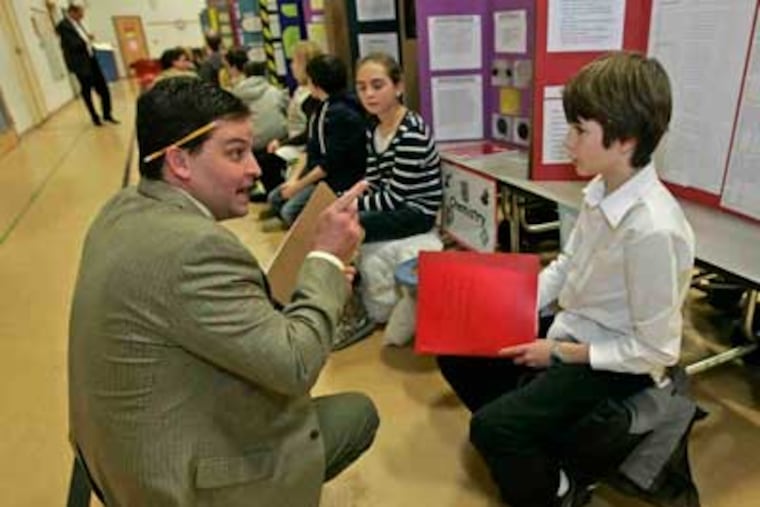Pa. school's science fair gets professional input
Ten-year-old Rylie Hijosh wanted to prove that her stepbrother was wrong. Boys do not have a better memory than girls.

Ten-year-old Rylie Hijosh wanted to prove that her stepbrother was wrong. Boys do not have a better memory than girls.
So the East Coventry Elementary School student turned to science. She designed an experiment aimed at testing memory, and had a grown-up scientist help her do it.
Rylie's Visual and Auditory Gender Memory Project was one of nearly 200 student entries in the Chester County school's annual science fair. The competition, held last week for fourth to sixth graders, gave the students the chance to test an experimental hypothesis - and get advice from working scientists along the way.
The school formed a partnership several years ago with the Malvern-based pharmaceutical firm TetraLogic. The company's scientists visit the school to meet with students, starting in November, help them formulate their experiments for the fair, and then return to judge the contest.
"We noticed that some students have parents who get really involved and others have to work on their own," said Mark McKinlay, chief scientific officer at TetraLogic. "So we suggested coming over in advance to sit down with each kid and help."
The partnership and early guidance from working scientists has helped spur interest in the fair, which increased by about 50 students this year, said Mary-Rita Bonner, the fair's coordinator.
The scientists help students formulate a scientific investigation that has a hypothesis, experimental procedures, data analysis, a conclusion, and a bibliography.
This year, student projects included tests of the hackability of a computer password, the chewiness quotient of chocolate-chip cookies, and the floating qualities of bubbles blown from a bottle.
East Coventry's contest has the highest level of student participation of the five elementary schools in the Owen J. Roberts School District, said Heidi Lehmann, the district's supervisor for science and technology.
"One of the reasons is the partnership with TetraLogic," Lehmann said. "To have someone from outside talk to them and talk about what are your controls, procedures, and how are you going to test this, I think the connection is very helpful."
At their end, the scientists at TetraLogic are researching a cancer-treatment drug, which is in clinical trials at Fox Chase Cancer Center and the Abramson Cancer Center of the University of Pennsylvania. The firm has attracted $63 million in venture capital investment since it was founded in 2003.
Last Friday, after results of the judging were revealed, 15 students from East Coventry advanced to the Chester County Science Research Competition to be held March 3-4. Winners of the county competition go on to the Delaware Valley Science Fair in April. And then the region's very best advance to the Intel International Science and Engineering Fair in May.
"I'm old enough to remember the volcanoes," said Mary Curley, communications director at the Chester County Intermediate Unit, which runs the county science fair. "Now, the sophistication is really increasing, especially at the high school level where you have students creating their own apps."
Among the East Coventry Elementary School winners was Rylie Hijosh and her memory project.
"I like testing people, seeing the scores - and proving to my brother that I was right," Hijosh said.
Stepbrother Travis Grosser, whose own experiment tested the speed and travel time of several types of balls when hit by a device built with the help of his grandfather, said that he was now convinced by Rylie's results.
She asked her sample of 10 girls and 10 boys - which included Travis - to spend 90 seconds studying three photos, then list the items depicted in them.
The girls beat the boys, but not by much.
The scientists see their involvement as a way to encourage an interest in science at a young age.
"Science in this country is in such bad shape," McKinlay said. "We are falling further and further behind. I spoke to a group of postdoctoral [science] students at Penn, and there were hardly any Americans."
East Coventry is doing its part. The science fair is a big production and all-day affair, with each student interviewed by a judge for about five minutes.
During Ethan Melniczek's interview, the 9-year-old discussed beaming a laser through Jell-O.
"I found it would go through the red Jell-O . . . but not the blue, probably because it's too dark," Ethan said.
Would he do anything differently next time? asked Martin Graham, vice president of development at TetraLogic.
"Next time, I'll try green Jell-O," Ethan said.